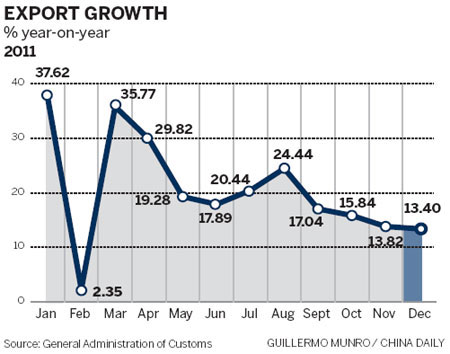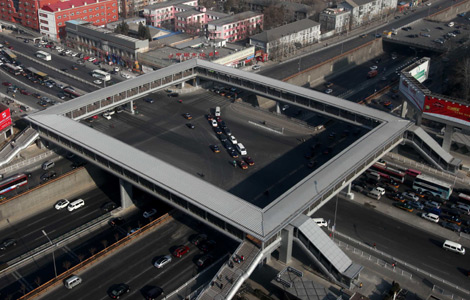Trade surplus continues declining trend
Updated: 2012-01-11 07:18
By Ding Qingfen and Yu Ran (China Daily)
|
|||||||||
Falls for third consecutive year as global demand shrinks for exports
BEIJING / SHANGHAI - China's trade surplus narrowed further for the third consecutive year in 2011 to below $160 billion, while exports declined due to the European debt crisis and the sluggish US economy.
Global demand for made-in-China goods will continue to be weak in the coming year, especially with eurozone uncertainty creating "downside" risks for the economy, economists warned.
 |
Statistics released by the General Administration of Customs on Tuesday showed the trade surplus for 2011 decreased by 14.5 percent from a year earlier to $155.14 billion. Exports grew by 20.3 percent and imports by 24.9 percent year-on-year during the same period. The previous year saw exports grow by 31.3 percent and imports by 38.7 percent.
China is still the largest global exporter and the second-largest importer next to the US, according to the customs administration.
"Although growth in exports and imports slowed, especially in the second half of last year, China's foreign trade is getting more balanced and the surplus is gradually narrowing," a statement on the customs administration website said.
The trade surplus has been narrowing since the global financial crisis erupted in 2008. It decreased by 34.2 percent to $196 billion in 2009, dropping further by 6.4 percent year-on-year to $183 billion in 2010.
China's year-on-year export growth has been on the decline since August. That month saw shipments surge by 24.4 percent, but by December it was down to 13.4 percent to $174.72 billion.
"We are not optimistic about the outlook for exports this year," Li Wei, economist at Shanghai-based Standard Chartered, said.
With the eurozone teetering on recession and the US still to anchor its recovery, exports will slow further and "we expect single-digit growth for the first quarter," Li said.
"And the contribution of exports to GDP will also shrink."
Minister of Commerce Chen Deming said at the annual national work conference last week that the ratio of China's surplus to its GDP is expected to fall to "2 percent" in 2011 from 3.1 percent in 2010.
Economists expressed concern that export decline will hamper the economy.
The biggest "downside" risk for China's economy is external weakness, a report by Barclays said.
"The nation's export growth may slow to 10 percent this year, while import growth may decelerate to 13 percent," it said.
Lu Zhengwei, chief economist at Industrial Bank, agreed: "The export trend will have a direct impact on the nation's economy."
Import growth has also been declining. Imports for December rose by 11.8 percent year-on-year, the lowest for two years, bolstering the prospect for monetary easing, economists said.
Grimmer situation
Both Chen and Vice-Commerce Minister Zhong Shan warned recently that the external trade environment will be bleak this year.
Liang Yaowen, director-general of the Department of Foreign Trade and Economic Cooperation of Guangdong province, told China Daily recently that companies in the nation's largest export region are under growing pressure as labor costs and the price of raw materials rise and the currency appreciates.
"Foreign trade will probably grow by single digits this year," Liang predicted.
The yuan surged to a high against the dollar in December, breaking the 6.3 barrier for the first time in 18 years.
US officials, including Treasury Secretary Timothy Geithner, have repeatedly called for the yuan to appreciate further.
"The government has to maintain a stable yuan" or the economy will be damaged, Lu said.
"Demand from overseas has been dropping since 2008 due to the severe economic environment in the US and Europe and the situation got worse last year," said Liu Mengjue, manager of Wenzhou Jingyi Clothes, a garment exporter in Zhejiang province.
To lower operational costs, the company cut the number of employees last year by half to 500.
Related Stories
China to tackle trade surplus 2007-05-16 15:50
Weaker demand hits trade surplus 2012-01-06 08:00
Trade surplus shrinks as imports post surge 2011-11-11 07:37
Weak export demand hits trade surplus in 2011 2012-01-06 07:12
China's trade surplus to narrow to $150b 2011-12-15 13:26
- China's Dec CPI growth dips to 4.1%
- Cross-border channels for the yuan to expand
- Huaneng sees profits drop 21.7% last year
- China says energy consumption is controllable
- Oil leak risk rises along coast
- Company blacklist for quality problems
- Premier Wen looks at the big picture
- China's cross-border RMB settlement hits $408b








